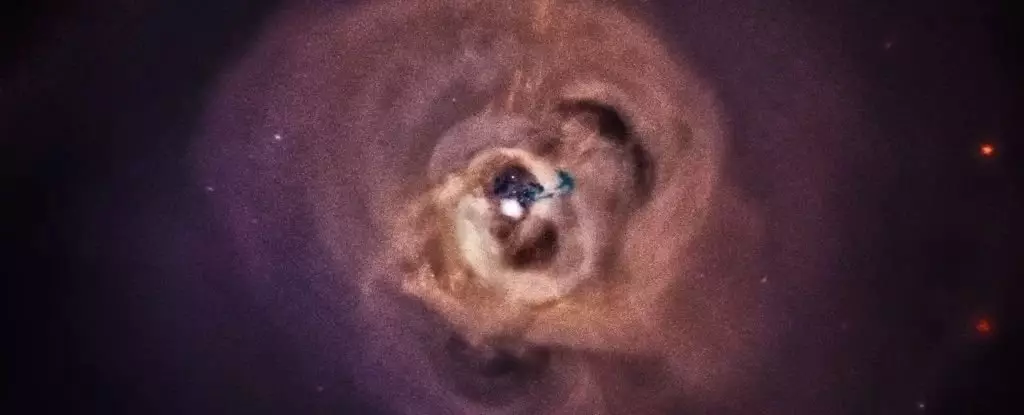The universe, with its vast expanse and enigmatic phenomena, often leaves humanity in awe. Among its many marvels, supermassive black holes stand out not just due to their immense gravitational pull but also for the eerie sounds that emanate from their surroundings. NASA’s groundbreaking work has transformed the elusive sounds of a supermassive black hole in the Perseus cluster into an auditory experience that is as intriguing as it is chilling.
In a remarkable scientific achievement, NASA has successfully captured and sonified sound waves from a supermassive black hole located 250 million light-years away at the heart of the Perseus cluster. These sound waves, originally too low in frequency for human ears to detect, have been manipulated—transposed an astonishing 57 and 58 octaves higher—allowing us a glimpse into the symphony created by these cosmic giants. This innovation reveals a haunting howling, reminiscent of something both spooky and somewhat angry, that beckons us to ponder deeper questions about the nature of sound in the universe.
In 2003, astronomers unlocked the mystery behind these sounds, identifying acoustic waves traversing the vast sea of gas enveloping the black hole. While our ears cannot perceive sound in space due to the lack of a medium, the presence of dense gases surrounding the black hole permits sound to travel. Thus, the misconception that space is a perfect vacuum, devoid of sound, is dispelled. The low notes generated by the Perseus black hole are not only a scientific curiosity but a testament to the complexity of cosmic interactions.
The process of extracting and transposing these sound waves is a feat of modern science. Originally, the lowest audible note detected from the black hole was a B-flat, residing over 57 octaves below middle C, making its actual frequency 10 million years—a truly monumental measurement. By playing these sound waves in an anti-clockwise direction from the center of the black hole, researchers created an atmospheric audio snapshot that allows us to perceive something that is infinitely beyond our reach.
Through this sonification, sounds emerge as echoes rippling outward into intergalactic space, amplified to pitches far beyond their original frequencies, at rates of 144 quadrillion and 288 quadrillion times higher. This transformation not only makes the cosmic symphony accessible to our ears but also enriches our understanding of the complexities of gas dynamics surrounding black holes.
Sound waves’ significance in the universe transcends mere curiosity. Within the intergalactic realm, there exists something known as the intracluster medium—the hot and dense gaseous environment between galaxies. Here, sound waves propagate, transporting energy through plasma and thus potentially influencing the temperature regulation critical for star formation. This relationship highlights a complex interplay, suggesting that sound—often seen as a mere byproduct—plays a vital role in the structural evolution of galaxy clusters over time.
Moreover, the heat generated within the intracluster medium causes it to glow brilliantly in X-ray wavelengths, enabling scientists to detect these sound waves. Instruments like the Chandra X-ray Observatory have been pivotal in capturing these interactions, proving that sound in the cosmic world is indeed a reflection of the intricate processes that govern the behavior of matter in extreme environments.
The sonification of the Perseus black hole is just one chapter in a larger narrative exploring the acoustics of the cosmos. Another celebrated black hole, M87*, was thrust into the limelight when it became the first to be directly imaged by the Event Horizon Telescope collaboration. The visual data collected from multiple instruments, including those observing X-ray, visible light, and radio wavelengths, were also sonified. This innovative methodology allowed scientists to experience cosmic phenomena through an auditory lens, creating an entirely new perspective on the universe.
Additionally, the artistic yet scientific endeavor of transforming visual data into sound reveals hidden aspects of the data itself. This cross-disciplinary approach fosters a richer understanding of astronomical phenomena, illuminating the mysteries of space in ways that mere observation cannot achieve.
As we delve deeper into the sounds of supermassive black holes, we embrace a medium for exploration that bridges science and the human experience. The eerie howlings of the Perseus cluster represent not only the acoustic footprint of an astronomical phenomenon but a symphony of the universe itself. With every wave transposed, we inch closer to deciphering the vast complexities of the cosmos, where sound and silence intertwine, reflecting the enigmatic dance of creation and destruction within the depths of space. Through these resonant echoes, humanity finds a connection to the cosmos—one that resonates long after the sounds fade into silence.

